Dentistry Today is pleased to present our Practice Pyramid Series, to assist today’s practitioners. Various leading clinicians will be featured, demonstrating the application of new technologies. Dr. Lou Shuman and Amy Morgan, both of the Pride Institute, will provide technological product introductions and practice management implications in each article. All technologies presented in this series are 2009 Pride Institute “Best of Class” Technology Winners, chosen through an unbiased assessment selection process in conjunction with a known technology expert, Dr. Larry Emmott.
I can’t tell you how many times I have heard from my patients: “Dr. Ruiz, can you do my work without anesthesia? I hate the feeling of being numb.” One of the best practice builders is painless anesthesia, and with proper technique, pain during the anesthetic injections should be very little. However, still remaining is the other really unpleasant part of being anesthetized, the 4 to 5 hours of postoperative numbness. We all dislike this part, and this unpleasantness is in many cases responsible for keeping our patients away from doing necessary dental treatment. In some cases, patients may even cancel an appointment if they suspect it may interfere with an important activity after their dental visit. Well, now we have a cutting-edge new drug, phentolamine mesylate (OraVerse [Novalar]), that may be the solution to these problems.
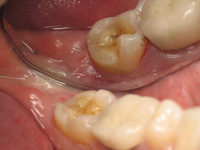 |
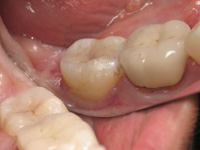 |
|
Figure 1. Supragingival preparation for a partial coverage all-ceramic onlay replacing the fractured cusp. |
Figure 2. Restoration after cementation with a resin cement. |
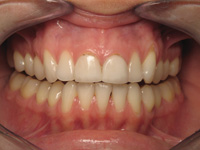 |
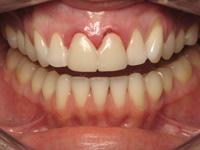 |
|
Figure 3. Preoperative view showing 2 old veneers with staining and poor morphology. |
Figure 4. Immediate postoperative view of gingivectomy and temporary veneers. |
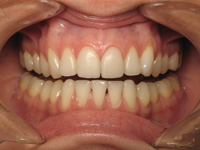 |
| Figure 5. One-week postoperative view of 2 bonded porcelain veneers. |
WHAT IS ORAVERSE AND HOW IS IT USED
OraVerse is an FDA-approved anesthesia reversal drug which cuts the postoperative numbness time in half, and often even faster, without any known serious side effects. It is injected in a 1:1 ratio to the anesthetic quantity administered, after the procedure is finished.
OraVerse can be used for the most basic dental procedures where we would expect a minimum postoperative pain, such as hygiene procedures, fillings, and the preparation and cementation of supragingival indirect restorations (ie, porcelain onlays, veneers, and all-ceramic crowns). It should not be used on procedures where considerable post-operative pain is expected, such as after a crown preparation with deep retraction cord placement, periodontal surgery, endodontic procedures or oral surgery. In these cases, a longer postoperative numbness is desirable for the patient’s comfort. In all cases, it would be wise to recommend that the patient take 400 mg to 800 mg of ibuprofen to minimize any discomfort after the anesthesia is reversed.
How Phentolamine Mesylate Is Used in Our Practice
I have a busy private practice and implementation of new procedures or new things learned are important keys to success. OraVerse can be a great adjunctive service and practice builder which will enhance the patient’s perception of the practice and the value received for fees charged. It is important to understand that, although there is a small profit associated with it, its true value is as a practice builder in providing a new way to improve the overall dental experience for our patients.
Educating and informing our patients is always vital in implementing any new technique or technology, so in my practice we have placed a large display informing our patients that “Having a ‘fat lip’ for hours after your dental appointment is a thing of the past! Ask us about OraVerse.” We have also included quotes in our reception area slide presentation from satisfied patients who have experienced the positive effects of OraVerse. In our practice, anesthesia reversal is offered as an optional procedure. We charge a nominal fee to cover the cost of the drug and the additional time it will take to do the injection. The following clinical examples demonstrate how successful this additional service can be within the scope of many clinical procedures.
| Now, Who Pays the Bill—Or Would That Be Fee? Anesthesia Reversal Agents |
|
Tom M. Limoli, Jr |
CASE 1
A very successful and busy 40-year-old TV producer was scheduled to do a porcelain onlay preparation on tooth No. 18 due to caries and a fractured disto-bucal cusp. After being seated, the patient stated that the only reason she was present at her appointment was because we offered the anesthesia reversal procedure. This is because she had an important meeting that evening, approximately 4 hours later, and she did not want to be numb for the event. I was careful not to promise that the anesthesia would be completely gone by the time of the meeting, but she was assured that with OraVerse, she should experience at least a 50% reduction the time she would feel the effect of the local anesthetic. We performed the supragingival preparation (Figure 1), and the following day she sent us an e-mail thanking us for offering OraVerse. Furthermore, she said that she wanted to have OraVerse administered after every subsequent procedure. Two weeks later, the restoration was cemented (Figure 2). If we had performed a traditional PFM crown, we would have had to place retraction cord in the gingival sulcus. If the patient had had considerable postoperative pain, this would have made the use of OraVerse less desirable, and as a result she may not have had a positive experience. Supragingival bonded restorations have many advantages, are typically easier to perform with less postoperative pain, and are much more gentle to the gingival tissue than any traditional subgingival PFM crown and bridge procedure.1
| The Technological Implications of OraVerse |
|
Lou Shuman, DMD HOW IT WORKS OBSERVED BENEFITS
POTENTIAL CHALLENGES AND OTHER OBSERVATIONS
Such events have apparently been very uncommon with OraVerse. Clinicians should be alert to the signs and symptoms of these events, particularly in patients with a history of cardiovascular disease. |
CASE 2
The next case was an actress and dancer in her late twenties who wanted to replace 2 porcelain veneers because of marginal staining and to improve form (Figure 3). The treatment plan included gingivectomy on the 2 centrals to improve gingival symmetry. She had been informed about OraVerse, and although she had requested to have it used at the time of the veneer preparations, I recommended against it. This is because I knew she would have postoperative pain after the gingivectomy (Figure 4). After the gingiva healed, the restorative work was finished. OraVerse was used during the final impressions and for final cementation of the supragingival veneers. The patient was very happy with the aesthetic results and the much reduced post-treatment anesthesia time (Figure 5
).
| Practice Management Ramifications for OraVerse |
|
Amy Morgan The doctor and team must be prepared to “inform before they perform” to make sure:
Your assistants will need to manage the inventory, and the entire team will need to be comfortable with the benefits so that they can inspire patients to embrace this new innovation. They must also be comfortable with the additional fee. |
CASE 3
It is rare when I can use myself as an example of a satisfied patient, but this is one of those cases. Recently, I had to have a minor bilateral procedure on the maxillary arch. I was anesthetized for the procedure with one carpule of Septocaine (1:100,000 epinephrine) (Septodont) in each side. Immediately after the procedure was finished, I received one injection of OraVerse on the right side, and (by choice) nothing on the left. The left side was numb for 5 hours while the right side was back to normal within 1 hour. I had slight pain on the OraVerse side at the injection site (this is normal and expected) and took 2 (200 mg) ibuprofen tablets that took care of the pain in about 20 minutes. I wanted to experience first-hand the benefits of phentolamine mesylate. I am one of those patients who hates the feeling of being numb long after the treatment is done, and would use OraVerse every time that it is indicated.
CONCLUSION
When used as indicated, this new anesthesia reversal agent is an effective way to reduce the amount of time a patient feels numbness related to the administration of local anesthetics. It is a practice builder giving doctors an effective way to help their patients realize a more comfortable dental experience.
REFERENCE
- Ruiz JL. Supragingival dentistry using metal-free restorations. Dent Today. 2008;27:104-109.
Dr. Ruiz is course director of the USC Advanced Esthetic Dentistry Continuum and clinical instructor at USC, associate instructor and mentor at PCC Utah, teaching with Dr. Gordon Christensen, and is an independent evaluator of dental products for CRA. He is a Fellow of the AGD and practices general dentistry in the Studio District of Los Angeles, where he treats many stars and entertainers. He lectures both nationally and internationally on aesthetic dentistry and leadership. He can be reached at (818) 558-4332 or via email at ruiz@drruiz.com.
Disclosure: Dr. Ruiz reports no conflicts of interest.
Dr. Shuman is president of Pride Institute and is well known in the dental community for his leadership and expertise in the areas of strategic relations, emerging technologies, Internet strategy, practice management, and marketing. The Pride Institute’s goal is to utilize their reputation of integrity and fairness as a foundation in educating the community within the field of emerging technologies. He previously served as vice president of clinical education and then vice president of strategic relations for Align Technology for 7 years. He is a member of Dentistry Today’s Dental Advisory Board and has been listed in Dentistry Today’s Leaders in Continuing Education from 2004 to 2008, and is currently listed as a Leader in Dental Consulting. He is proud to be collaborating in this exciting new Dentistry Today article series. He can be reached via e-mail at lshumani@msn.com. Follow Dr. Lou Shuman on Google+, on Twitter (@LouShuman) or subscribe to Lou Shuman’s posts on Facebook.
Disclosure: Dr. Shuman reports no conflicts of interest.
Ms. Morgan serves as the CEO of Pride Institute. She is a dental consultant and international lecturer. Over the years, Ms. Morgan has facilitated the successful revitalization of thousands of dental practices using Pride Management Systems. She can be reached at amym@prideinstitute.com.
Disclosure: Ms. Morgan reports no conflicts of interest.


